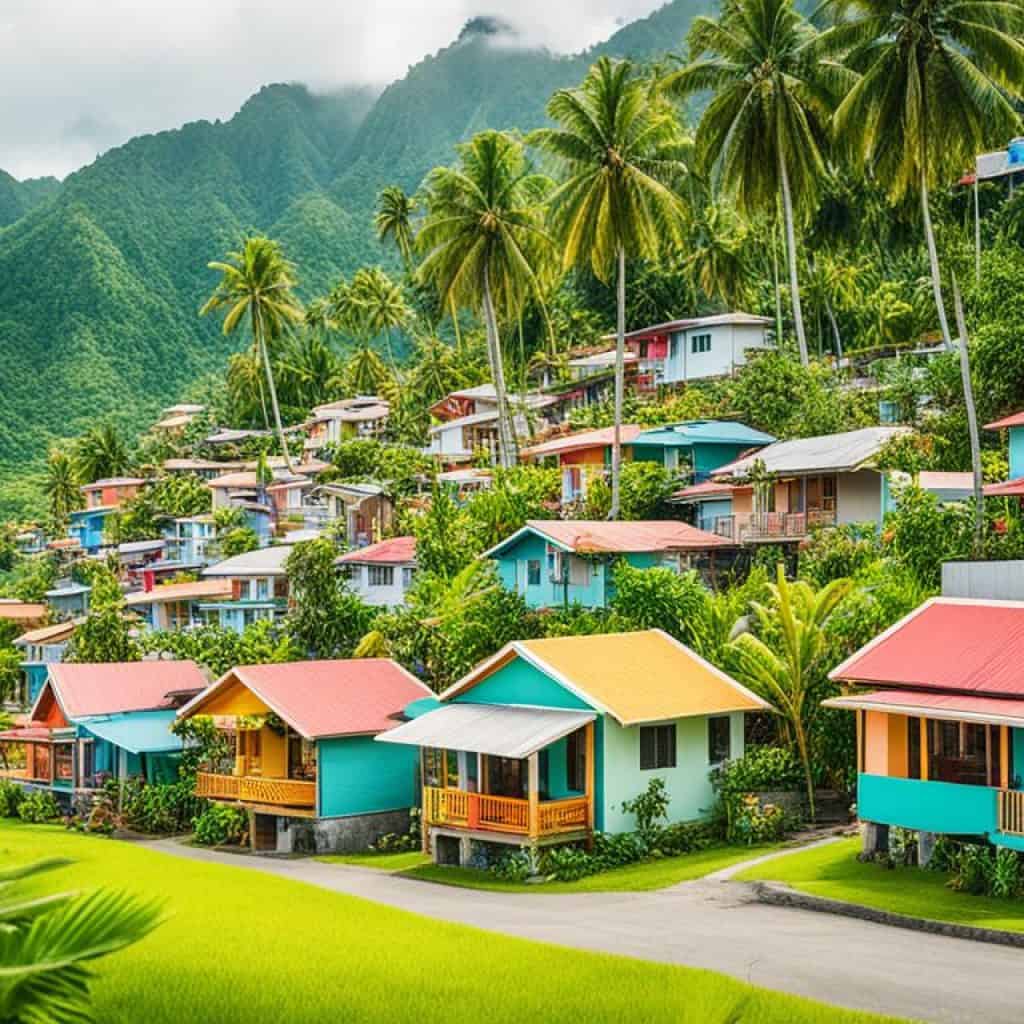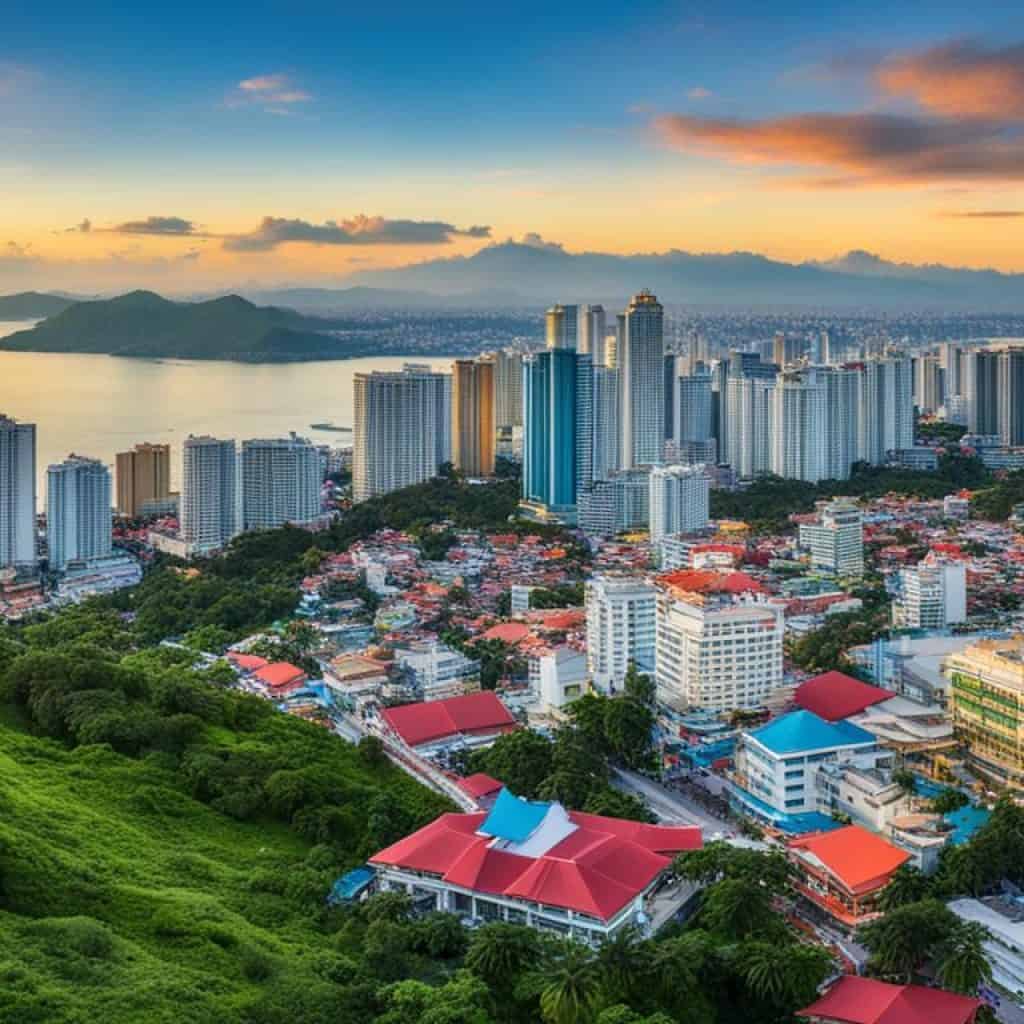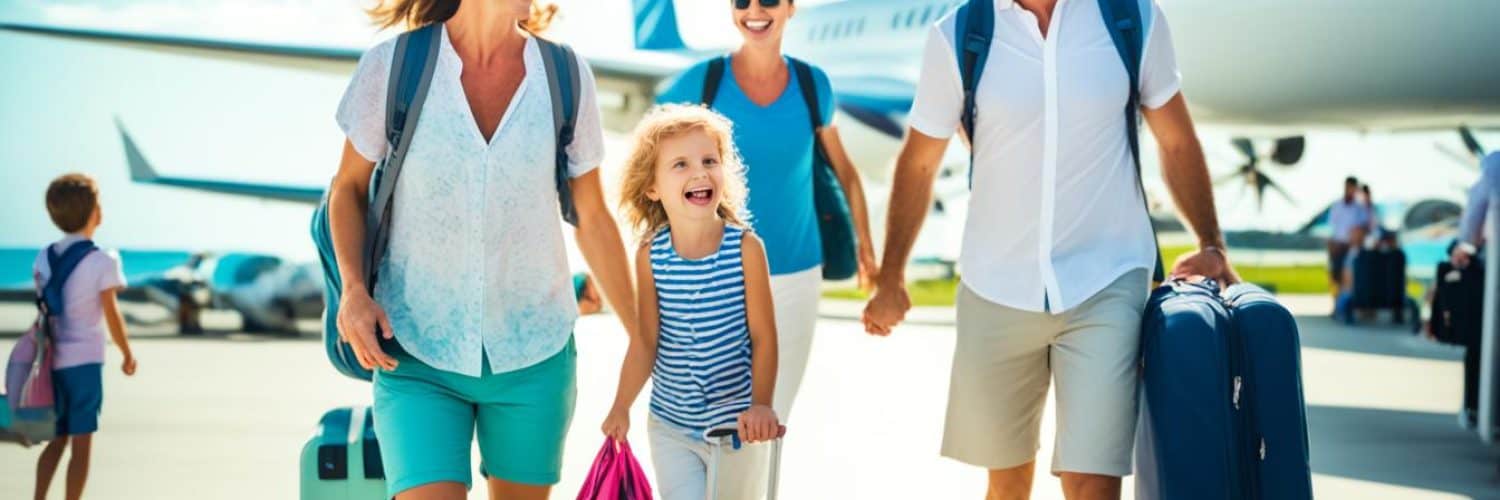Are you ready for a tropical adventure in a vibrant culture? Moving to the Philippines offers an exciting opportunity to immerse yourself in a rich and diverse country with breathtaking landscapes and warm-hearted people. But before you set off on this new chapter of your life, there are a few things you need to know. How do you navigate the visa requirements? What are the costs of living in the Philippines? And what about healthcare and education? In this guide, we’ll provide you with all the essential information you need to plan your move to the Philippines and make your dream a reality.
Key Takeaways:
- Learn about the visa options and requirements as a US citizen moving to the Philippines.
- Understand the cost of living and discover affordable housing options.
- Explore the healthcare system and find the right insurance for your needs.
- Discover the education opportunities available for you and your family.
- Get familiar with transportation and banking services to make your life easier.
The Philippines Quick Facts
The Philippines is a country with a rich cultural heritage and a diverse population. The capital city is Manila, and the main languages spoken are Filipino and English. The population of the country is approximately 117 million, and the currency used is the Philippine peso. The Philippines is known for its strong Christian influence, with Christianity being the main religion.
When moving to the Philippines, it is important to understand the cultural customs and traditions of the Filipino people. The Filipino culture and customs are deeply rooted in a blend of indigenous, Spanish, and American influences, creating a unique and vibrant society. The Filipinos are known for their warm hospitality, strong family ties, and love for celebrations and festivals.
Additionally, it is essential to consider the cost of living in the Philippines. The cost of living in the Philippines is generally lower compared to many Western countries, making it an attractive destination for expatriates. Everyday expenses such as meals, groceries, and transportation are more affordable. Housing options are also available at various price ranges, allowing individuals to find accommodation that suits their budget. Overall, the Philippines offers a more cost-effective lifestyle without compromising on quality.
Filipino culture is a beautiful tapestry of traditions, festivals, and values that make the Philippines a truly unique and captivating country to live in.
The Local Cuisine
The Filipino cuisine is a reflection of the country’s diverse history and cultural influences. It features a wide array of flavors, spices, and cooking techniques. Some popular Filipino dishes include adobo (marinated meat in soy sauce and vinegar), sinigang (sour soup), lechon (roast pig), and halo-halo (a refreshing dessert). Exploring the local cuisine is an exciting adventure that will surely tantalize your taste buds.
Fiestas and Festivals
The Philippines is known for its vibrant fiestas and festivals, where communities come together to celebrate and showcase their cultural traditions. Festivals such as the Sinulog Festival in Cebu, Ati-Atihan Festival in Kalibo, and Pahiyas Festival in Lucban are just a few examples of the colorful and lively events that take place throughout the year. These celebrations are an opportunity to experience the joyous spirit of the Filipino people and immerse yourself in their rich cultural heritage.
Respect for Elders
In Filipino culture, respect for elders is deeply ingrained. It is customary to show reverence and deference to older family members and individuals in the community. This is demonstrated through gestures such as addressing elders with “po” and “opo,” using “mano po” to seek blessings from elders by taking their hand and placing it on your forehead, and offering assistance or support when needed.
Understanding the Filipino culture and customs will not only help you navigate your new life in the Philippines but also foster stronger relationships and a deeper appreciation for the local way of life.
Can a US Citizen Live in the Philippines?
As a US citizen, you have the opportunity to legally move to the Philippines for a long-term stay. However, the duration of your stay will depend on the type of visa you choose. Fortunately, the Philippines offers various visas to cater to different purposes, including work, study, retirement, starting a business, or joining family. It is crucial to understand and comply with the Philippine visa requirements to ensure a smooth transition to your new life in the country.
If you are planning to work in the Philippines, you will need to obtain a work visa and apply for a work permit. This visa allows you to work for a Filipino company and contribute your skills and expertise to the local workforce. On the other hand, if you are retiring in the Philippines, you can apply for a retirement visa, known as the Special Resident Retiree’s Visa (SRRV). This visa is available for individuals over the age of 35 who wish to enjoy their retirement years in the tropical paradise of the Philippines.
For those who have Filipino spouses and want to join their families in the Philippines, the spouse visa is the appropriate option. This visa allows you to live in the country and be reunited with your loved ones. Additionally, if you are planning to study in the Philippines, there are student visas available for international students who aspire to pursue their education in this culturally rich country.
The Philippines is not only known for its picturesque landscapes and warm hospitality but also its vibrant expat community. With a growing number of expatriates choosing the Philippines as their second home, you can expect to find a diverse and welcoming community eager to connect and share their experiences. The expat community in the Philippines offers a support system, valuable insights, and opportunities to build friendships with people from around the world.
Immigration and Visas
If you’re planning to work for a Filipino company, you’ll need a work visa. Not only do you need to obtain a work permit, but you also have to meet the specific requirements set by the Philippine government. This visa allows you to legally work and stay in the country while contributing your skills and expertise to the local workforce.
Retirement Visa
If you’re dreaming of spending your golden years in the Philippines, the retirement visa, officially known as the Special Resident Retiree’s Visa (SRRV), is the perfect choice. This visa is available for individuals aged 35 and above who wish to retire in the Philippines. It offers numerous benefits, including permanent residency, tax exemptions, and easier access to healthcare services.
Spouse Visa
If you’re a spouse of a Filipino citizen, the spouse visa allows you to join your family in the country. This visa enables you to reside in the Philippines and enjoy all the benefits of living in a vibrant and diverse community. The requirements for the spouse visa may vary, so make sure to check the specific guidelines provided by the Philippine authorities.
Each visa type has its own set of requirements and application procedures. It’s essential to familiarize yourself with the Philippine visa requirements and gather all the necessary documentation to ensure a smooth application process. The Philippines welcomes US citizens with open arms, so start planning your exciting journey today!
| Visa Type | Requirements | Application Process |
|---|---|---|
| Work Visa | Work permit, job offer, proof of qualifications | Submit application, attend interview, provide supporting documents |
| Retirement Visa | Proof of retirement, minimum deposit, medical clearance | Submit application, undergo medical examination, make required deposit |
| Spouse Visa | Marriage certificate, proof of relationship, background check | Submit application, provide supporting documents, attend interview |
Applying for the right visa is crucial in ensuring a successful and fulfilling experience in the Philippines. Take the time to understand the Philippine visa requirements and carefully follow the application procedures to embark on your new adventure smoothly.
Living in the Philippines: The Basics
Moving overseas can be an exciting but challenging adventure, and the Philippines is no exception. However, the country offers a good quality of life at an affordable cost, making it an attractive destination for expatriates. The cost of living in the Philippines is generally lower compared to the US, allowing you to stretch your budget further and enjoy a comfortable lifestyle.
When it comes to everyday expenses, such as meals, groceries, and transportation, you’ll find that they are more affordable in the Philippines. This means you can dine out more frequently, enjoy fresh, delicious local produce, and explore all the wonders the country has to offer without breaking the bank.
“Living in the Philippines is a dream come true. Not only is it incredibly affordable, but the warm weather, friendly locals, and stunning landscapes make it a paradise worth calling home.” – Jane Smith, US Expat
One of the major concerns when relocating to a new country is finding suitable housing. Fortunately, the Philippines has a wide range of housing options to cater to different budgets. Whether you prefer a luxurious apartment in the heart of Manila or a cozy beachfront cottage in a tranquil province, you’ll find affordable housing options that suit your needs.
Overall, living in the Philippines offers a unique blend of affordable living costs and a high quality of life. You’ll have the opportunity to immerse yourself in a vibrant culture, explore stunning natural landscapes, and build connections with both the local community and the expat population.
Image:
Healthcare and Insurance in the Philippines
The healthcare system in the Philippines is primarily comprised of a public healthcare system. While it provides basic medical services, the quality may not meet international standards. This is why many expats living in the Philippines opt for private health cover to have access to higher quality facilities and services.
It is advisable for expats to obtain comprehensive health insurance to ensure they can receive the necessary medical care and treatment. Private health insurance in the Philippines is generally affordable, and there are various providers to choose from. Having private health cover gives expats peace of mind knowing that they can receive quality healthcare when needed.
Private health insurance offers a range of benefits, including coverage for hospitalization, outpatient care, prescription medications, and specialist consultations. Some insurance plans also provide additional benefits such as dental and vision coverage.
When choosing a private health insurance plan, it is important to carefully review the coverage options and exclusions. Consider factors such as the network of hospitals and clinics, reimbursement policy, and customer reviews. Comparing different insurance providers and plans will help you find the most suitable coverage for your healthcare needs.
The Advantages of Private Health Cover in the Philippines
- Access to higher quality healthcare facilities and services
- Coverage for hospitalization, outpatient care, medications, and specialist consultations
- Additional benefits such as dental and vision coverage
- Affordable premium options
Choosing the Right Private Health Insurance
| Things to Consider | Questions to Ask |
|---|---|
| Network of Hospitals and Clinics | Which hospitals and clinics are included in the insurance network? |
| Reimbursement Policy | What is the process for claiming reimbursements? |
| Additional Benefits | Does the insurance plan offer dental and vision coverage? |
| Premium Options | What are the different premium options and their coverage? |
By considering these factors and asking the right questions, you can make an informed decision when selecting private health cover in the Philippines.
It’s important to note that private health insurance does not replace the need for a comprehensive health and wellness plan. Staying proactive about preventive care, maintaining a healthy lifestyle, and following recommended vaccinations and screenings are essential for your well-being while living in the Philippines.
Banking and Finances in the Philippines
If you are moving to the Philippines, it is crucial to have a local bank account to effectively manage your finances. Fortunately, most major banks in the country accept US citizens as account holders, although some may require in-person verification. Opening a local bank account allows you to easily receive and withdraw money, pay bills, and handle other financial transactions.
It is important to research the various banking services and fees associated with international transfers to ensure a smooth financial experience in the Philippines. Different banks may offer different services and charge varying fees, so take the time to compare and select the one that best suits your needs. Additionally, consider the availability of ATMs and banking services in your desired location, especially if you plan to live outside major cities like Manila.
By setting up a local bank account, you can enjoy the convenience of managing your money in the Philippines, whether it’s for daily expenses, saving, or making investments.
Benefits of Having a Local Bank Account:
- Easier access to funds
- Convenient bill payments and transactions
- Ability to receive money from local sources
- Avoidance of high currency exchange fees
- Potential eligibility for local banking benefits and promotions
Considerations for International Transfers:
When dealing with international transfers, it is important to be aware of the fees and requirements involved. Banks may charge fees for both incoming and outgoing transfers, and exchange rates can vary. It is advisable to compare fees and rates from different providers, including online money transfer services like Wise, to ensure you get the most out of your financial transactions.
“Having a local bank account in the Philippines will make managing your finances easier and more convenient. It allows you to have quick access to your funds and conduct transactions with ease. Don’t forget to compare banking services and fees to make an informed choice.”
Bank Comparison in the Philippines
| Bank Name | Services Offered | ATM Availability | Fees |
|---|---|---|---|
| Banco de Oro (BDO) | Savings accounts, checking accounts, loans, credit cards | Wide network of ATMs nationwide, including major cities | Varies depending on the transaction |
| Bank of the Philippine Islands (BPI) | Savings accounts, checking accounts, loans, credit cards | Extensive ATM network nationwide | Varies depending on the transaction |
| Metrobank | Savings accounts, checking accounts, loans, credit cards | ATMs available in major cities | Varies depending on the transaction |
| Security Bank | Savings accounts, checking accounts, loans, credit cards | ATMs available in major cities | Varies depending on the transaction |
Source: Banco de Oro, Bank of the Philippine Islands, Metrobank, Security Bank
Keep in mind that fees and services may change over time, so it is recommended to visit the official websites of the banks for the most up-to-date information.
Having a local bank account in the Philippines is an essential step in managing your finances effectively. It provides convenience, accessibility, and opportunities to take advantage of local banking services. Research and compare different banks to find the one that suits your needs and offers the best benefits.
Education in the Philippines
The education system in the Philippines is known for its strong American influence, providing a familiar environment for US students transitioning to the country. With a combination of public and private schools, there are ample opportunities for quality education. English is widely spoken in the Philippines, making it easier for international students to communicate and adapt.
For expat families seeking an international curriculum, there are reputable international schools available in major cities like Manila. These schools offer a broader range of subjects and a multicultural learning environment that caters to the needs of expatriate children. International schools in the Philippines often follow international educational standards, ensuring a seamless transition for students.
The school year in the Philippines typically runs from June to March, with two main semesters. This differs from the traditional September to June schedule in many Western countries. Additionally, there are various educational opportunities for both children and adults, including vocational training, college programs, and specialized courses.
Benefits of International Schools in the Philippines
- Provides a diverse and multicultural learning environment
- Offers a broader curriculum with an international focus
- Facilitates cultural integration and global perspectives
- Promotes language proficiency in English and other languages
- Provides extracurricular activities and opportunities for personal growth
International schools in the Philippines prioritize the holistic development of students, nurturing their physical, intellectual, and emotional well-being. These institutions aim to create well-rounded individuals who are prepared to thrive in an increasingly globalized world.
| Pros | Cons |
|---|---|
| High-quality education | Higher tuition fees compared to public schools |
| Experienced and qualified teachers | Competition for enrollment in top international schools |
| International accreditation and recognition | May have limited availability in certain locations |
| Opportunities for cultural exchange and diversity | Transition and adjustment for some students |
Choosing an international school in the Philippines provides an excellent educational foundation with a global perspective. It allows students to develop critical thinking skills, cultural awareness, and adaptability, preparing them for future academic and career success.

Education is the passport to the future, for tomorrow belongs to those who prepare for it today. – Malcolm X
Getting Around in the Philippines
The Philippines, comprising thousands of islands, offers unique challenges when it comes to transportation. However, there are various options available to help you navigate the country and reach your desired destinations.
In major cities like Manila, public transportation is plentiful and includes buses and tricycles. Buses are a popular choice for getting around the city and offer affordable fares. Tricycles, small motorized vehicles with sidecars, are another common mode of transportation in urban areas.
For traveling between islands, domestic flights and ferries are convenient options. Domestic flights connect major cities and tourist destinations, providing a faster and more efficient way to explore different parts of the country. Ferries are a popular choice for island hopping and can be a scenic way to travel between smaller islands.
However, it’s important to note that traffic congestion can be a challenge in urban areas, especially during peak hours. This can significantly impact travel times and should be taken into consideration when planning your itinerary.
While driving is an option in the Philippines, it is not recommended for expats due to road conditions and safety concerns. The roads can be crowded, and driving styles may differ from what you’re accustomed to. It’s advisable to rely on local transportation options or hire a trusted driver if necessary.
Transportation Options in the Philippines:
| Transportation Mode | Advantages | Disadvantages |
|---|---|---|
| Buses | – Affordable fares – Extensive route network – Convenient for city travel | – Traffic congestion during peak hours |
| Tricycles | – Easy access to urban areas – Affordable fares | – Limited seating capacity – Vulnerable to traffic congestion |
| Domestic Flights | – Fast and efficient travel between major cities and islands – Expands option for exploring different regions | – Prone to flight delays and cancellations – Additional expenses for airfare |
| Ferries | – Scenic island hopping experience – Provides access to smaller islands | – Trip schedules may be subject to changes – Seasickness during rough weather |
Exploring the Philippines and experiencing its diverse beauty is an adventure worth undertaking. By understanding the available transportation options and planning accordingly, you can make the most of your travel experiences in this tropical paradise.
Costs of Moving to the Philippines
Moving to the Philippines involves various expenses that you need to consider when planning your relocation. From shipping your belongings to covering travel costs, it’s essential to account for these factors in your budget. Here are some key costs to keep in mind:
- Shipping Costs: The cost of shipping a full container from the US to the Philippines can range from $850 to $4,500, depending on the volume of your belongings and the destination.
- Travel Expenses: You will also need to consider the costs of flights for yourself and your family to reach your new home in the Philippines. Be sure to compare prices and plan accordingly.
- Pet Transportation: If you have pets, you may need to incur additional expenses for their transportation. Ensure you have the necessary documentation and budget for any fees associated with transporting your furry companions.
It’s essential to obtain quotes from shipping companies to get a better understanding of the cost of moving your belongings to the Philippines. Plan your budget accordingly to ensure a smooth and stress-free transition. By factoring in these costs, you can make informed financial decisions and have a clear understanding of your overall expenses.
Best Places to Live in the Philippines
The Philippines offers a range of locations to live, each with its own unique charm. When considering the best places to live in the Philippines, factors such as employment opportunities, vibrant lifestyle, luxury amenities, cool climate, breathtaking views, and safety should be taken into account. Here are three popular choices:
Manila
Manila, the capital city of the Philippines, is a top choice for expats due to its bustling atmosphere and numerous job opportunities. It offers a vibrant lifestyle with a variety of entertainment, shopping, and dining options. Although traffic can be busy, Manila provides a cosmopolitan experience with a mix of modern and historical attractions.
Makati
Makati is a city in Metro Manila known for its skyscrapers, luxury amenities, and thriving business district. It is a prime location for professionals seeking employment opportunities in multinational companies. Makati offers a range of entertainment venues, high-end shopping malls, and a vibrant nightlife scene.
Tagaytay
For those looking for a peaceful and scenic environment, Tagaytay is a charming city located in the province of Cavite. It is known for its cool climate and breathtaking views of Taal Lake and Volcano. Tagaytay offers a laid-back lifestyle with plenty of nature parks, organic farms, and cozy restaurants offering farm-to-table experiences.
When choosing a place to live in the Philippines, it is essential to consider factors such as proximity to work, safety, and personal lifestyle preferences. Whether you prefer the vibrant city life of Manila, the luxury amenities of Makati, or the scenic beauty of Tagaytay, there is a perfect place for everyone in the Philippines.
| Location | Main Features |
|---|---|
| Manila | Bustling atmosphere, job opportunities, vibrant lifestyle, entertainment options |
| Makati | Skyscrapers, luxury amenities, business district, shopping malls, nightlife |
| Tagaytay | Cool climate, breathtaking views, nature parks, organic farms, cozy restaurants |

Pros and Cons of Living in the Philippines
Like any expat destination, living in the Philippines has its pros and cons. It’s important to consider both sides before making the decision to move. Here are some key factors to help you weigh your options:
Pros:
- Affordable Cost of Living: The Philippines offers a lower cost of living compared to many Western countries. You can enjoy a comfortable lifestyle without breaking the bank.
- Beautiful Landscapes: The Philippines is known for its breathtaking natural beauty, from stunning beaches and crystal-clear waters to lush mountains and tropical forests.
- Vibrant Expat Community: The Philippines has a thriving expat community, providing opportunities to connect with people from around the world and form new friendships.
Living in the Philippines allows you to experience a unique blend of cultures, indulge in delicious cuisine, and immerse yourself in a welcoming and diverse community.
Cons:
- High Crime Rates: While the Philippines offers many safe and secure areas, some cities may have higher crime rates. It’s important to research and choose a location with a good reputation for safety.
- Risk of Natural Disasters: The Philippines is prone to typhoons, earthquakes, and volcanic eruptions. It’s crucial to be prepared and stay updated with local emergency protocols.
- Hot and Humid Weather: The tropical climate can be challenging for those who are not accustomed to hot and humid conditions. It’s important to adapt and stay hydrated.
Consider these pros and cons based on your own preferences and priorities. Moving to the Philippines can be an exciting adventure, but it’s essential to make an informed decision that aligns with your lifestyle and goals.
Managing Your Finances with Wise
When it comes to managing your finances in the Philippines, Wise (formerly TransferWise) is your smart choice. With Wise, you can easily and affordably handle international money transfers with competitive exchange rates and transparent fees.
One of the key features of Wise is the ability to open a multi-currency account. This allows you to hold and exchange different currencies, including the Philippine peso, without worrying about excessive bank fees or unfavorable exchange rates. With a multi-currency account, you can conveniently manage your money and make transactions in various currencies.
Wise also offers a prepaid card that enables you to spend like a local in the Philippines. By using the Wise prepaid card, you can avoid unnecessary bank fees and take advantage of favorable exchange rates. Whether you’re shopping, dining, or exploring the vibrant cities and beautiful landscapes, the Wise prepaid card ensures a seamless and cost-effective experience.
Managing your finances in the Philippines has never been easier with Wise. Take advantage of their convenient services and low-cost solutions to make the most of your financial transactions and enjoy a hassle-free experience.
To learn more about Wise and their services in the Philippines, visit their official website.
Wise in the Philippines: Key Features
| Benefits | Description |
|---|---|
| Low-Cost Transfers | Competitive exchange rates and transparent fees for international money transfers. |
| Multi-Currency Account | Hold and exchange different currencies, including the Philippine peso, conveniently in one account. |
| Prepaid Card | Spend like a local and avoid excessive bank fees with the Wise prepaid card. |
| User-Friendly Platform | Easy-to-use online platform and mobile app for seamless financial management. |
| Secure and Regulated | Wise is licensed and regulated by financial authorities, ensuring the safety of your funds. |
Conclusion
Moving to the Philippines offers an extraordinary opportunity to embark on an exciting adventure in a tropical oasis. With its vibrant culture, picturesque landscapes, and warm-hearted expat community, the Philippines is a destination that promises an enriching experience. To ensure a seamless transition, it is crucial to familiarize yourself with the visa requirements, cost of living, healthcare options, and other essential factors.
By conducting thorough research and planning ahead, you can navigate the process with confidence. Consider utilizing resources like Wise to manage your finances effectively and avoid unnecessary fees. With their convenient services, you can send money internationally, hold different currencies, and even enjoy the benefits of a Wise prepaid card for seamless transactions in the Philippines.
Embrace this new chapter in your life by immersing yourself in the beauty of the Philippines and forming connections with the friendly local community and fellow expats. While there may be challenges along the way, the rewards of living in this tropical paradise will far outweigh them. So, go ahead and take that leap of faith â a vibrant and fulfilling experience awaits you in the Philippines.
FAQ
What is the culture and customs like in the Philippines?
The Philippines has a rich cultural heritage and a diverse population. The main languages spoken are Filipino and English, and Christianity is the main religion. It is important to understand and respect the cultural customs and traditions of the Filipino people when moving to the Philippines.
Is the cost of living in the Philippines affordable?
Yes, the cost of living in the Philippines is generally lower compared to many Western countries. Everyday expenses such as meals, groceries, and transportation are more affordable, making the Philippines an attractive destination for expatriates looking for a more affordable lifestyle.
Can a US citizen legally move to the Philippines?
What are the visa options for US citizens moving to the Philippines?
US citizens have several visa options for moving to the Philippines. The main visa types include work visa, retirement visa, and spouse visa. Each visa has specific requirements and application procedures, so it is important to ensure you have the appropriate visa for your specific circumstances.
What is the cost of healthcare in the Philippines?
The Philippines has a public healthcare system, but its quality may not meet international standards. Expats often choose private health cover to have access to higher quality facilities and services. It is advisable to obtain comprehensive health insurance to ensure you can receive the necessary medical care and treatment.
Can US citizens open a local bank account in the Philippines?
Yes, most major banks in the Philippines accept US citizens as account holders. However, some banks may require in-person verification. It is advisable to research the banking services and fees associated with international transfers to ensure convenient financial management.
What is the education system like in the Philippines?
The education system in the Philippines is based on the American model, making it easier for US students to adjust. The country has a mix of public and private schools, and English is widely spoken. International schools are also available in major cities, offering a broader curriculum for expat families.
What are the transportation options in the Philippines?
In major cities like Manila, there are various modes of public transportation, including buses and tricycles. Domestic flights and ferries are popular options for traveling between islands. However, traffic congestion can be a problem in urban areas, and driving is not recommended for expats due to road conditions and safety concerns.
What are the costs involved in moving to the Philippines?
Moving to the Philippines involves several costs, such as shipping your belongings and travel expenses. The cost of shipping a full container from the US to the Philippines can range from $850 to $4,500, depending on the volume and destination. It is important to obtain quotes from shipping companies and plan your budget accordingly.
Where are the best places to live in the Philippines?
The Philippines offers a range of locations to live, each with its own unique charm. Manila, the capital city, is a popular choice for expats due to its employment opportunities and vibrant lifestyle. Other attractive options include Makati, known for its skyscrapers and luxury amenities, and Tagaytay, with its cool climate and breathtaking views.
What are the pros and cons of living in the Philippines?
Living in the Philippines has its pros and cons. Some of the advantages include affordable cost of living, beautiful landscapes, and a vibrant expat community. However, high crime rates, the risk of natural disasters, and the hot and humid weather can be considered disadvantages. It is important to weigh the pros and cons based on your individual preferences and priorities.
How can I manage my finances in the Philippines with Wise?
Wise provides a convenient and low-cost way to manage your finances in the Philippines. With Wise, you can send money internationally at competitive exchange rates and with transparent fees. You can also open a multi-currency account to hold and exchange different currencies, including the Philippine peso. Wise offers a prepaid card that allows you to spend like a local in the Philippines, avoiding excessive bank fees and unfavorable exchange rates.


















Add comment